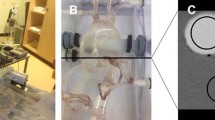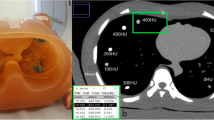Abstract
Gadolinium has a higher atomic mass (64) than iodine (53). The K-edge absorption energy of gadolinium is 50.2 keV, which is in the absorbed wavelength range of the X-rays used by a CT scanner, suggesting that it has a high X-ray absorption ability. This study examined the effects of a gadolinium-based MRI contrast medium on the quality (mAs) and the quality (kVp) of radiation during a X-ray scan. A contrast medium phantom was manufactured after diluting the contrast medium to various concentrations. A CT scanner (Siemens, Somatom Senation 64, Germany) was used to obtain images by changing the quality of radiation from 80 kVp to 100, 120, and 140 kVp. At a constant quality of radiation of 120 kVp, the mAs was changed from 100 mAs to 200 and 300 mAs and images were obtained under each condition. The Hounsfield units (HUs) in a test tube were measured for analysis and comparison. The contrast enhancement by the contrast medium for CT scanning was 100% at a tube voltage of 80 kVp. The contrast enhancements at 100 kVp, 120 kVp, and 140 kVp were 93.8%, 87.7%, and 69.5%, respectively. In addition, although the quantity increased a fixed tube voltage, the HU of the test tube remained relatively constant, indicating that the absorption of the contrast medium had little association with the quantity of X-rays but had some correlation with the quality of radiation. A tube voltage of 80 kVp or lower is recommended when a MRI contrast medium is used CT scanning. When MRI scanning and X-ray scanning are conducted together, X-ray scanning should be performed first or after sufficient gadolinium contrast medium has been excreted.
Similar content being viewed by others
References
G. N. Holland, R. C. Hawkes and W. S. Moore, J. Comput. Assist. Tomo. 4, 429 (1980).
R. W. Katzberg, Radiology 235, 752 (2005).
J. O. Hoppe, A. A. Larsen and F. Coulston, J. Pharmacol. Exp. Ther. 116, 394 (1956).
D. Meyer, M. Schaefer and B. Bonnemain, Invest. Radiol. 23(Suppl 1), 232 (1988).
H. Katayama, K. Yamaguchi, T. Kozuka, T. Takashima, P. Seez and K. Matuura, Radiology 175, 621 (1990).
K. L. Nelson, L. M. Gifford, C. Lauber-Huber, C. A. Gross and T. A. Lasser, Radiology 196, 439 (1995).
D. S. Gierada and K. T. Bae, Radiology 210, 829 (1999).
U. Nyman, B. Elmstahl, P. Leander, M. Nilsson, K. Golman and T. Almen, Radiology 223, 311 (2002).
W. Luboldt, E. M. De Santis, A. von Smekal and M. Reiser, Invest. Radiol. 32, 690 (1997).
H. A. Goldstein, F. K. Kashanian, R. F. Blumetti, W. L. Holyoak, F. P. Hugo and D. M. Blumenfield, Radiology 174, 17 (1990).
H. P. Niendorf, J. C. Dinger, J. Haustein, I. Cornelius, A. Alhassan and W. Clauss, Eur. J. Radiol. 13, 15 (1991).
M. R. Prince, C. Arnoldus and J. K. Frisoli, J. Magn. Reson. Imaging 6, 162 (1996).
D. B. Spring, M. A. Bettmann and H. E. Barkan, Radiology 204, 325 (1997).
Y. Kinno, K. Odagiri, K. Andoh, Y. Itoh and K. Tarao, Am. J. Roentgenol. 160, 1293 (1993).
M. Ishida, H. Sakuma, S. Murashima, J. Nishida, M. Senga, S. Kobayasi, K. Takeda and N. Kata, J. Magn. Reson. Imaging 29, 205 (2009).
T. Albrecht and P. Dawson, Br. J. Radiol. 73, 878 (2000).
H. S. Thomsen, S. K. Morcos and P. Dawson, Clin. Radiol. 61, 905 (2006).
F. J. Palmer, Australas. Radiol. 32, 426 (1988).
Author information
Authors and Affiliations
Corresponding author
Rights and permissions
About this article
Cite this article
Yu, SM., Park, Y., Dong, KR. et al. Study on the effects of gadolinium-based MRI contrast medium on X-ray scanning. Journal of the Korean Physical Society 60, 142–148 (2012). https://doi.org/10.3938/jkps.60.142
Received:
Accepted:
Published:
Issue Date:
DOI: https://doi.org/10.3938/jkps.60.142




